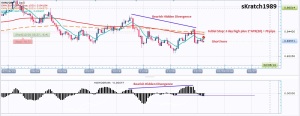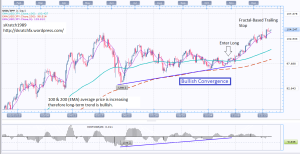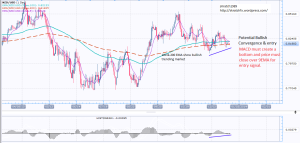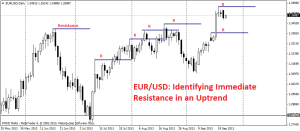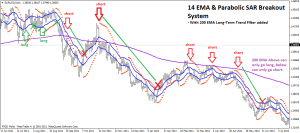Every good trend-following method should automatically limit the loss on any position, long or short, without limiting the gain. Whenever a trend, once established, reverses quickly, there is always a point, not far above or below the extreme reached prior to the reversal, at which evidence of a trend in the opposite direction is given. At that point any position held in the direction of the original trend should be reversed – or at least closed out – at a limited loss. Profits are not limited because whenever a trend, once established, continues in a sustained fashion without giving any evidence of trend reversal, the trend-following principle requires that a market position be maintained as long as the trend continues.
– Richard Donchian
What is a Trend-Following (TF) system?
Sometimes we get so distracted by indicators, timeframes, etc. that we forget to step back and remind ourselves what it is exactly that we are trying to do.
Through the development of a TF system, our goal is to identify when the market has “broken out” of a volatility-confined area. This area may be identified through standard deviation, moving averages, Donchian channels, etc. When there is enough volatility in the market so that price “breaks above” either the upper or lower band, trend-following channels kick in. It is estimated that most markets trend 20% of the time, while 80% of the time it remains confined in a sideways movement. If we are operating a TF system, we want to be in the market during that 20% extreme volatility to catch the big moves. Otherwise, if we take entry signals with weak volatility we are likely to get whiplashed.
At the center of the band of price movement, we can place a moving average (or Donchian centerline). At any one time, price is oscillating around this centerline. When volatility increases, and price breaks out of the band, we enter long with the hope that the volatility will pull the average up above the entry price, and therefore lock in a gain.
When we design a trading system, we need to ask ourselves three questions:
- When do I get in?
- When do I get out with a loss?
- When do I get out with a win?
Let’s try to answer these questions from a Trend-Following perspective.
- When do I get in? Get in when there is proof of market strength. This may be measured through a movement greater than the average daily range, outside of a bandwidth, ADX greater than 30, Divergence, Breakouts, Close must be above the four previous closes, etc.
- When do I get out with a loss? (a) If our reason for entry has been negated. (i.e. failure to make a new high in 3 days, drop in ADX, movement against position by greater than one average daily range) (b) Adverse movement greater than my risk tolerance. Hopefully your system is designed so that your risk tolerance is large enough to keep you in a position until your reason for entry has been negated.
- When do I get out with a win? (a) Until the market shows weakness. (i.e. failure to make a new high in 3 days, drop in ADX, movement against position by greater than one average daily range) (b) Change in trend direction. (i.e. Fractal-based Trailing stop, moving average cross) (c) Until the position reaches a certain level of profit (not always a recommended reason for taking profit because since trend-following systems generate a limited number of profitable trades, we want to ride them out until they show weakness)

